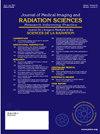运动侦察触发技术提高了胎儿大脑 3.0T 磁共振成像的质量
IF 1.3
Q3 RADIOLOGY, NUCLEAR MEDICINE & MEDICAL IMAGING
Journal of Medical Imaging and Radiation Sciences
Pub Date : 2024-10-01
DOI:10.1016/j.jmir.2024.101515
引用次数: 0
摘要
目的单次快速自旋回波(SSFSE)是胎儿脑磁共振成像(MRI)的主要成像和诊断序列。该序列受母体呼吸运动的影响,质子在胎儿脑部某些水平的重复激发部分导致了高概率的串扰伪影,从而影响了图像质量,尤其是在 3 特斯拉下。方法对43例孕妇进行胎儿脑部核磁共振扫描,分别采用自由呼吸状态下的SSFSE扫描和运动侦察触发SSFSE扫描,获得同一胎儿的轴向脑部图像。采用自检验和配对 t 检验比较胎儿白质的信噪比(SNR)和对比度-信噪比(CNR)均匀性,进而评价两组图像质量的差异。结果 自由呼吸SSFSE和运动扫描触发SSFSE图像的信噪比分别为(99.93±36.16)和(120.18±44.58)(P<0.05),CNR均匀性分别为(32.67±21.07)和(7.00±6.69)(P<0.05)。结论 运动侦察触发 SSFSE 能显著提高胎儿脑部 MRI 图像的信噪比,有效减少串扰伪影。因此,它能清晰显示胎儿脑部结构,为诊断提供更有效的信息。本文章由计算机程序翻译,如有差异,请以英文原文为准。
Motion scout trigger technique improves the quality of 3.0T MRI images of the fetal brain
Purpose
Single-shot fast spin-echo (SSFSE) is the premier imaging and diagnostic sequence for fetal brain magnetic resonance imaging (MRI). This sequence is affected by maternal respiratory motion, and the repeated excitation of protons at some levels of the fetal brain partially leads to a high probability of cross talk artifact, which affects the image quality, especially at 3 Tesla. In this paper, we will explore the application of motion scout trigger technology to reduce cross talk artifact in SSFSE images and improve image quality.
Methods
43 cases of fetal brain MRI scans were performed in pregnant women using SSFSE and motion scout trigger SSFSE scans in free breathing state, respectively to obtain axial brain images of the same fetus. Using self-control and paired t-test to compare the signal-to-noise ratio (SNR) and contrast-to-noise ratio (CNR) uniformity of fetal white matter, and then evaluate the difference in image quality between the two groups.
Results
The SNR of free-breathing SSFSE and motion scout trigger SSFSE images were 99.93±36.16 and 120.18±44.58 (P<0.05), and the CNR uniformity was 32.67±21.07 and 7.00±6.69 (P<0.05), respectively. All differences were statistically significant.
Conclusion
Motion scout trigger SSFSE can significantly improve the signal-to-noise ratio of fetal brain MRI images and effectively reduce cross talk artifact. Therefore, it can clearly display the fetal brain structure and provide more effective information for diagnosis.
求助全文
通过发布文献求助,成功后即可免费获取论文全文。
去求助
来源期刊

Journal of Medical Imaging and Radiation Sciences
RADIOLOGY, NUCLEAR MEDICINE & MEDICAL IMAGING-
CiteScore
2.30
自引率
11.10%
发文量
231
审稿时长
53 days
期刊介绍:
Journal of Medical Imaging and Radiation Sciences is the official peer-reviewed journal of the Canadian Association of Medical Radiation Technologists. This journal is published four times a year and is circulated to approximately 11,000 medical radiation technologists, libraries and radiology departments throughout Canada, the United States and overseas. The Journal publishes articles on recent research, new technology and techniques, professional practices, technologists viewpoints as well as relevant book reviews.
 求助内容:
求助内容: 应助结果提醒方式:
应助结果提醒方式:


